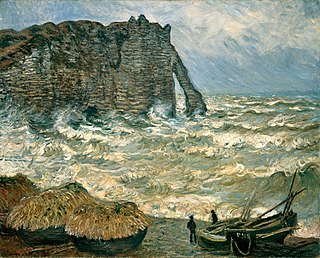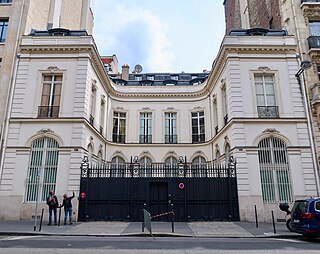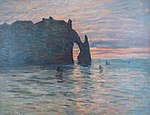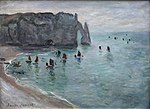
Oscar-Claude Monet was a French painter and founder of Impressionism painting who is seen as a key precursor to modernism, especially in his attempts to paint nature as he perceived it. During his long career, he was the most consistent and prolific practitioner of Impressionism's philosophy of expressing one's perceptions of nature, especially as applied to plein air (outdoor) landscape painting. The term "Impressionism" is derived from the title of his painting Impression, soleil levant, which was first exhibited in the so-called "exhibition of rejects" of 1874–an exhibition initiated by Monet and like-minded artists as an alternative to the Salon.

Étretat is a commune in the Seine-Maritime department in the Normandy region of Northwestern France. It is a tourist and farming town situated about 32 km (20 mi) northeast of Le Havre, at the junction of the D 940, D 11 and D 139 roads. It is located on the coast of the Pays de Caux area.

A catalogue raisonné is an annotated listing of the works of an artist or group of artists and can contain all works or a selection of works categorised by different parameters such as medium or period.

Haystacks is the common English title for a series of impressionist paintings by Claude Monet. The principal subject of each painting in the series is stacks of harvested wheat. The title refers primarily to a twenty-five canvas series which Monet began near the end of the summer of 1890 and continued through the following spring, though Monet also produced five earlier paintings using this same stack subject. A precursor to the series is the 1884 Haystack Near Giverny.

Water Lilies is a series of approximately 250 oil paintings by French Impressionist Claude Monet (1840–1926). The paintings depict his flower garden at his home in Giverny, and were the main focus of his artistic production during the last thirty years of his life. Many of the works were painted while Monet suffered from cataracts.
A Wildenstein Index Number refers to an item in a numerical system published in catalogues by Daniel Wildenstein, a scholar of Impressionism, who published catalogues raisonnés of artists such as Claude Monet, Édouard Manet and Paul Gauguin through his family business, Wildenstein & Company. In these catalogues, each painting by an artist was assigned a unique number. These index numbers are now used throughout the art world, in art texts, and on art websites to uniquely identify specific works of art by specific artists.

Alice Raingo Hoschedé Monet was the wife of department store magnate and art collector Ernest Hoschedé and later of the Impressionist painter Claude Monet.

The Stormy Sea in Étretat is an oil on canvas painting by French Impressionism painter Claude Monet, from 1883. It is held at the Musée des Beaux-Arts de Lyon.

The Magpie is an oil-on-canvas landscape painting by the French Impressionist Claude Monet, created during the winter of 1868–1869 near the commune of Étretat in Normandy. Monet's patron, Louis Joachim Gaudibert, helped arrange a house in Étretat for Monet's girlfriend Camille Doncieux and their newborn son, allowing Monet to paint in relative comfort, surrounded by his family.

Bords de la Seine à Argenteuil is an oil painting by an unknown artist. The painting is a landscape depicting the River Seine at Argenteuil in France. It is owned by Englishman David Joel.

Agnus Dei is an oil painting completed between 1635 and 1640 by the Spanish Baroque artist Francisco de Zurbarán. It is housed in the Prado Museum in Madrid, Spain. The Lamb of God is an allusion to Christ's title as recorded in John's Gospel, where John the Baptist describes Jesus as "The Lamb of God who takes away the sin of the World".

The Wildenstein Institute was a French art institute that published catalogues raisonnés and scholarly inventories.

Portrait of Père Paul, also known as Monsieur Paul or The Chef, is a painting by Claude Monet.

The Doge's Palace Seen from San Giorgio Maggiore is a 1908 painting by Claude Monet that resides in the collection of the Metropolitan Museum of Art. The painting, catalogued W1755 in the Wildenstein catalogue raisonné, is one of a series of six versions of this scene painted by Monet in 1908. Other versions are held by the Kunsthaus Zürich and the Solomon R. Guggenheim Museum.

Le Palais Ducal or The Doge's Palace is the name given to various oil paintings which depict the Doge's Palace made by Claude Monet during a visit to Venice in 1908.

Gare Saint-Lazare is a series of oil paintings by the French artist Claude Monet. The paintings depict the smoky interior of this railway station in varied atmospheric conditions and from various points of view. The series contains twelve paintings, all created in 1877 in Paris. This was Monet's first series of paintings concentrating on a single theme.

The Pyramides at Port-Coton, Rough Sea is a series of six paintings produced by Claude Monet in 1886. They all show the rocky Atlantic coast of Belle-Île-en-Mer, visited and painted in the plein air by the artist between 12 September and 25 October that year.

The Étretat Gardens is a cliff-top experimental garden with "living sculptures" in Étretat, Normandy, France. It surrounds a villa that once belonged to Madame Thébault, an actress from Paris, in the beginning of the 20th century. More than a century later, the garden was restored by a team led by the landscape architect Alexander Grivko of the British garden design and landscaping company IL Nature, who was inspired by the flora of the Normandy coast. It was reopened to the public in 2017.

View from Rouelles is an 1858 painting by Claude Monet. The painting depicts the landscape surrounding a small stream, either the Rouelles or the Lézarde, in the Rouelles district of Le Havre in Normandy, France. Painted when Monet was seventeen, it is the earliest known painting by the artist. The painting is signed "O. Monet", as it was painted before Oscar-Claude Monet dropped the 'Oscar' from his name in his early twenties.

































